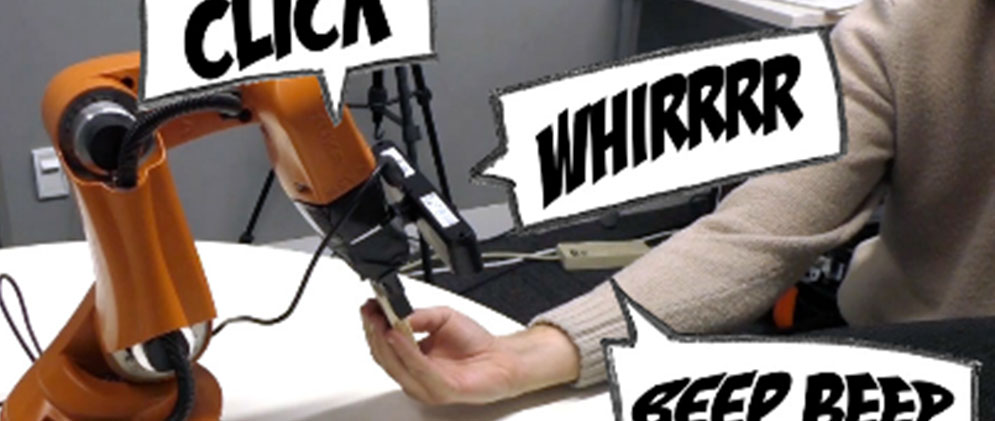Making Noise Intentional: Capturing and Designing Robotic Sonic Expressions
From The Theme
SMART OFFICE WORKFLOWS
WHAT IF
What if we could better understand how robotic sound influences human perceptions and interactions?
WHAT WE SET OUT TO DO
We set out to develop design heuristics for the sounds that are a byproduct of interactive objects in the technologically advanced workplace of the future. Specifically, we set out to study how the characteristics of a robot’s consequential sound (i.e., sound that results from motors, gears, etc) influence perception and interaction.
Researchers conducted acoustic analyses to gain a basic understanding of the spectral characteristics that contribute to a sound’s profile. In addition, we conducted lab and online experiments with users to study how sound influences robot perception and interaction, as well as competency, likability, and potential for distraction in a workspace.
WHAT WE FOUND
We found that the consequential sounds made by robots impact how humans perceive them, potentially hindering productivity. Changing the quality of sound (recorded from an expensive or inexpensive robotic arm) overlaid on a video of a moving robot arm resulted in different evaluations of competence, trust, aesthetics, and “humanlikeness”. Moreover, the presence of any sound, regardless of character, generally reduced aesthetic evaluations of the robot arm, supporting the earlier hypothesis that motor sounds in general have a negative impact on our perception of robots.
LEARN MORE
Moore, D., Tennent, H., Martelaro, N. and Ju, W. 2017. Making Noise Intentional: A Study of Servo Sound Perception. Proceedings of the ACM/IEEE International Conference on Human Robot Interaction (HRI). Vienna, Austria.
Tennent, H., Moore, D., Jung, M. and, Ju, W. 2017. Good Vibrations: How Consequential Sounds Affect Perception of Robotic Arms. Proceedings of the IEEE International Symposium on Robot and Human Interactive Communication (Ro-Man), Lisbon, Portugal.
PEOPLE BEHIND THE PROJECT
 Larry Leifer is Professor of Mechanical Engineering and Founding Director for the Center for Design Research at Stanford University. Dr. Leifer’s engineering design thinking research is focused on instrumenting design teams to understand, support, and improve design practice and theory. Specific issues include: design-team research methodology, global team dynamics, innovation leadership, interaction design, design-for-wellbeing, and adaptive mechatronic systems. Dr. Leifer received his BS in Engineering Science, his MS in Product Design and his PhD in Biomedical Engineering from Stanford University.
Larry Leifer is Professor of Mechanical Engineering and Founding Director for the Center for Design Research at Stanford University. Dr. Leifer’s engineering design thinking research is focused on instrumenting design teams to understand, support, and improve design practice and theory. Specific issues include: design-team research methodology, global team dynamics, innovation leadership, interaction design, design-for-wellbeing, and adaptive mechatronic systems. Dr. Leifer received his BS in Engineering Science, his MS in Product Design and his PhD in Biomedical Engineering from Stanford University.
 Wendy Ju is an Assistant Professor, Information Science, at Cornell Tech. At the time of this project and during her time at Stanford, she was the Executive Director of Interaction Design Research at the Center for Design Research (CDR). Dr. Ju’s research in the areas of physical interaction design and ubiquitous computing investigates how implicit interactions can enable novel and natural interfaces through the intentional management of attention and initiative.
Wendy Ju is an Assistant Professor, Information Science, at Cornell Tech. At the time of this project and during her time at Stanford, she was the Executive Director of Interaction Design Research at the Center for Design Research (CDR). Dr. Ju’s research in the areas of physical interaction design and ubiquitous computing investigates how implicit interactions can enable novel and natural interfaces through the intentional management of attention and initiative.
 Dylan Moore is a Ph.D. candidate in Mechanical Engineering performing research in the DesignX Lab supervised by David Sirkin and Larry Leifer. His research in engineering design adapts methods from psychology, acoustics, and cognitive science to design interactions between autonomous robots/vehicles, and pedestrians.
Dylan Moore is a Ph.D. candidate in Mechanical Engineering performing research in the DesignX Lab supervised by David Sirkin and Larry Leifer. His research in engineering design adapts methods from psychology, acoustics, and cognitive science to design interactions between autonomous robots/vehicles, and pedestrians.
 Nik Martelaro is a Ph.D. candidate in Mechanical Engineering at Stanford University. His interests primarily focus around interaction design, design methodology, product design, and human-robot interaction. He blends a background in mechanical engineering, mechatronic development, and product design methods to explore how designers and users can interact through physical product.
Nik Martelaro is a Ph.D. candidate in Mechanical Engineering at Stanford University. His interests primarily focus around interaction design, design methodology, product design, and human-robot interaction. He blends a background in mechanical engineering, mechatronic development, and product design methods to explore how designers and users can interact through physical product.
